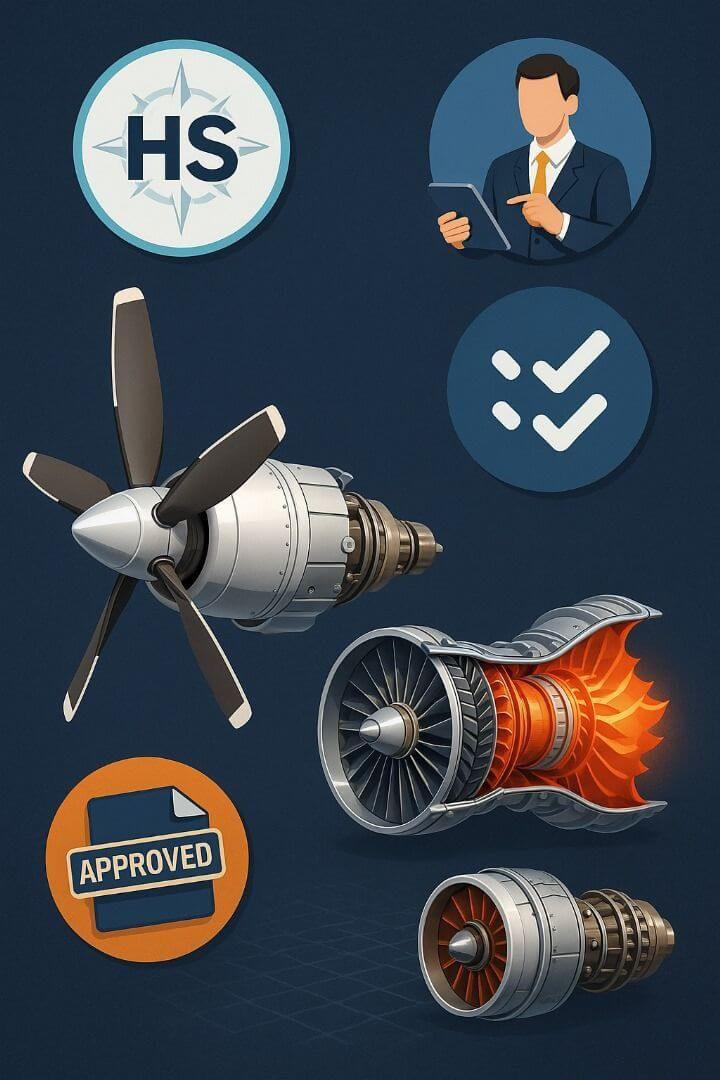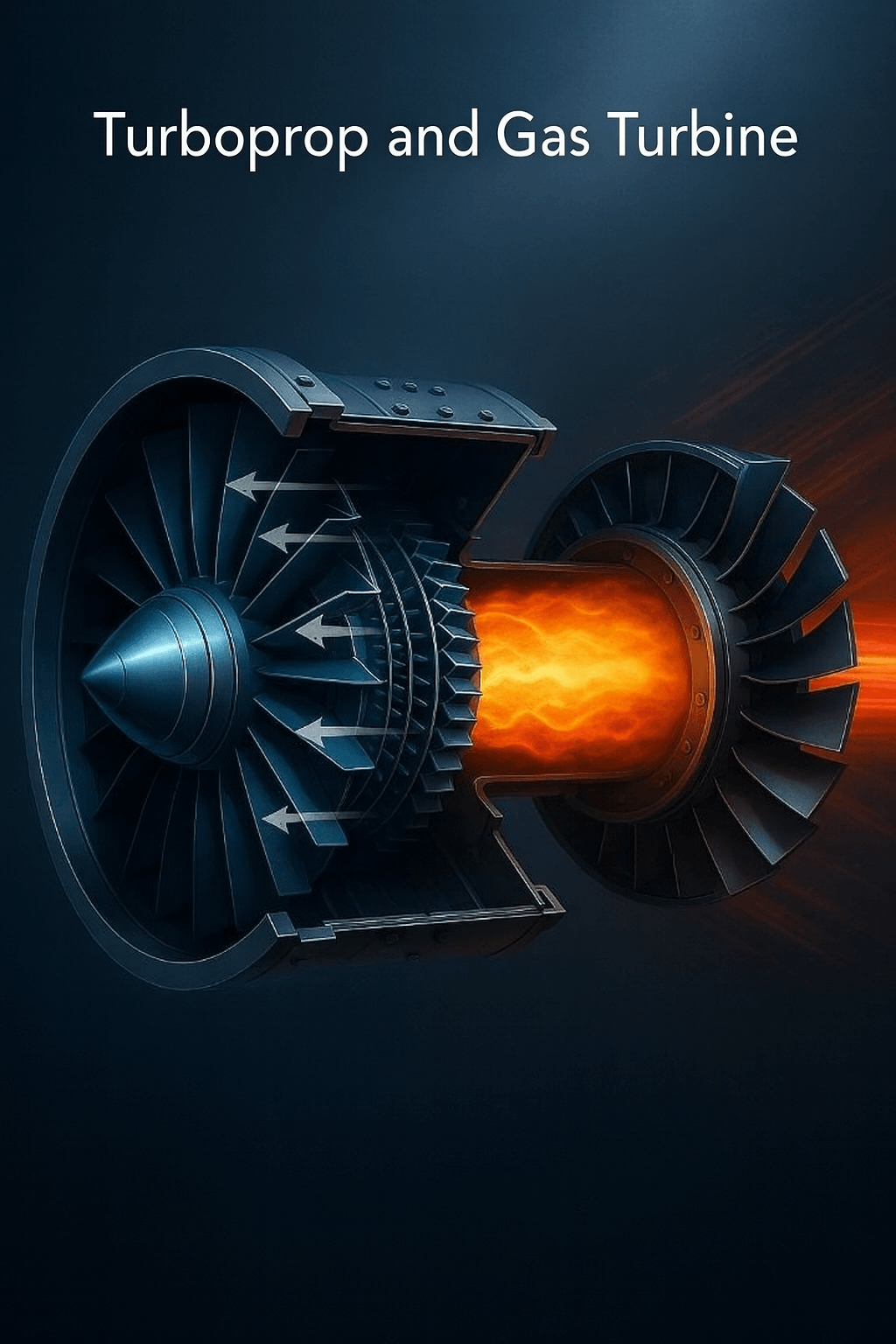Clearance of Turboprops and Gas Turbines from Iranian Customs (HS Code + Documents and Permits)
Turboprops and gas turbines are recognized as vital technologies in the aviation, maritime, and energy industries. Thanks to their unique capabilities in power generation and high efficiency, these engines have found a special place in equipment such as passenger and military aircraft, helicopters, ships, and power generators. Specialized understanding of these engines, along with familiarity with customs procedures and key clearance considerations, is highly important for importers and exporters of this equipment.

To estimate the time and cost of clearing turboprops and gas turbines, contact the experts at Saba Tarkhis.
Immediate Free Consultation1) Detailed Description of Goods: Nature, Structure, and Function
Structure and Function of a Turboprop (your text + completion)
A turboprop is a type of jet engine that mechanically transfers the energy generated by a gas turbine to a propeller. Due to lower fuel consumption compared with turbojets and high efficiency at low to medium speeds, this engine type suits small and medium-sized aircraft. In fact, turboprops combine characteristics of jet and piston engines and perform well in applications that require medium speeds, such as regional and military flights.
Main Components of a Turboprop (your text)
- Gas Turbine: The core of the engine that, by burning fuel, produces hot gases which cause the turbine to rotate.
- Gearbox: A system that reduces the turbine’s rotational speed to a suitable speed for the propeller.
- Propeller: Blades that convert mechanical energy into thrust.
Structure, Operation, and Applications of Gas Turbines (your text + completion)
Gas turbines fall into a broader category of equipment used in aviation, maritime, and energy industries. These engines consist of three main sections: compressor, combustion chamber, and turbine. The hot gases produced in the combustion chamber pass through the turbine and cause it to rotate. This mechanical energy can be used for various purposes, including power generation or propulsion for ships.
2) Types and Applications
Applications:
Aviation industry: Used in jet engines and turboprops for airplanes and helicopters.
Maritime industry: Used in large ships, warships, and submarines.
Power plants: Power generation in gas-fired power plants.
3) Key Points in Clearing Turboprops and Gas Turbines
Customs Tariff Code (HS Code):Turboprops: classified under code 841111, which includes “gas turbines for use in aircraft.”
General gas turbines: classified under codes 841181 and 841182, dedicated to gas turbines for power generation and other applications.
Required documents:
Technical specifications: including technical drawings, laboratory reports, and certificates of compliance with international standards.
Certificate of Origin: to confirm the manufacturing country and determine preferential tariffs.
Inspection certificate: technical inspection documents indicating the correctness and soundness of the imported equipment.
Technical and safety considerations:
Special permits: For importing this equipment, obtaining specific permits from relevant organizations such as the Civil Aviation Organization, Ports and Maritime Organization, or the Ministry of Energy is essential.
International standards: Gas turbines and turboprops must comply with international standards such as ISO, IEC, or FAA. These standards cover various aspects of design, manufacturing, testing, and installation.
Special conditions:
Technical inspections: Due to the high sensitivity of this equipment, detailed technical inspections may be required in the country of origin or destination. These inspections are performed by reputable and approved companies.
Insurance: Insurance is essential due to the high value of this equipment. This includes coverage for transport, potential damage, and technical defects.
4) Sample HS Code Table
| Item | Short Description | HS Code |
|---|---|---|
| Turboprop (for aircraft) | Gas turbine for aviation use | 841111 |
| Gas turbine for power generation | For gas-fired power plants | 841181 |
| Gas turbine for other applications | Industrial/marine applications | 841182 |
Determination of the final heading depends on technical specifications, power, fuel, application, and manufacturer’s documentation.
5) Special Conditions for Import and Export
Imports to Iran: Gas turbines and turboprops are mainly imported to Iran from countries such as Russia, the United States, and the European Union. Importing this equipment into Iran is highly important due to the need for advanced technologies and the replacement of old and inefficient equipment.
Exports from Iran: Due to technological limitations and international sanctions, Iran primarily imports this equipment and does not have significant exports in this field.
6) Trade Volume
Import volume to Iran: Due to the growing need to modernize air and maritime fleets and to develop gas power plants, imports of this equipment to Iran are considerable. Millions of dollars are spent each year to import gas turbines and turboprops.Export volume from Iran: Due to the lack of indigenous technology and reliance on imports, the export volume of this equipment from Iran is very limited.
7) Global Market: Major Exporters and Importers
Major exporters: United States of America: with companies such as General Electric (GE), Pratt & Whitney, and Rolls-Royce, which are among the largest manufacturers of turbine engines in the world.Russia: with companies like Saturn and Klimov, specializing in manufacturing gas turbines and aviation engines.
France: with companies such as Safran, producing advanced aviation engines and gas turbines.
Major importers: Developing countries: such as India, China, and Brazil, which seek to modernize their air and maritime fleets.
Middle Eastern countries: which, due to infrastructure development in energy and the need for modern equipment in oil and gas industries, are major importers of gas turbines.
8) Documents Required for Clearance
- Commercial Invoice, Packing List, Bill of Lading, cargo insurance policy.
- Complete technical specifications: drawings, laboratory reports, certificates of compliance with international standards.
- Valid Certificate of Origin (CO) for tariff preferences.
- Inspection certificate/Pre-shipment Inspection from reputable companies.
- Special permits related to the equipment (aviation/ports/energy).
Key Tips and Practical Recommendations
- Determine the HS Code before final purchase; any change in power/application can alter the tariff heading.
- Attach compliance certificates (ISO/IEC/FAA) and manufacturer test results.
- For aviation items, obtaining a permit from the Civil Aviation Organization is a prerequisite.
- For transport, insurance with “high-value machinery” coverage is recommended.

Frequently Asked Questions
What are the HS Codes for turboprops and gas turbines?
Turboprop: 841111; gas turbine for power generation: 841181; other applications: 841182. The exact heading depends on technical specifications and application.
Which documents are required for clearance?
Complete technical specifications, CO, pre-shipment inspection certificate, shipping documents (Invoice/Packing/Bill of Lading), specialized permits.
Is a permit from the Civil Aviation Organization required?
Yes, for items with aviation applications; depending on the application, permits from Ports and Maritime or the Ministry of Energy may also be required.
Special Services of Saba Brokerage
- Accurate customs processes: Due to the high sensitivity of this equipment, the best method for clearance is to use experienced customs brokers. These brokers can complete the clearance process with minimal cost and time by providing technical documents and coordinating with relevant public and private bodies.
Use of specialists: Utilizing consultants and experts in the field of aviation and maritime equipment can help importers carry out the clearance process more efficiently and with reduced risk.
Ultimately, the clearance of turboprops and other gas turbines requires technical knowledge and full awareness of customs regulations. Choosing an appropriate strategy for importing and clearing this equipment can play a significant role in reducing costs and increasing efficiency.
Clearance of special goods is possible upon obtaining specific permits.
.png)
